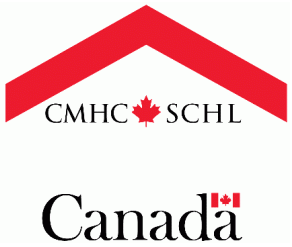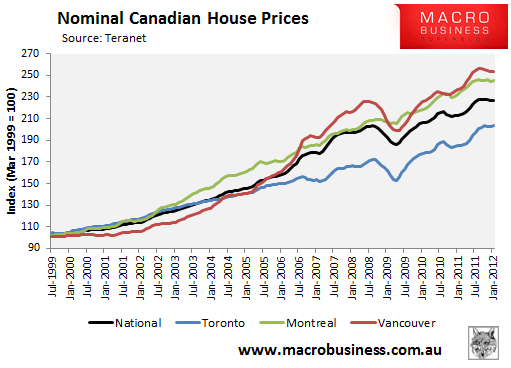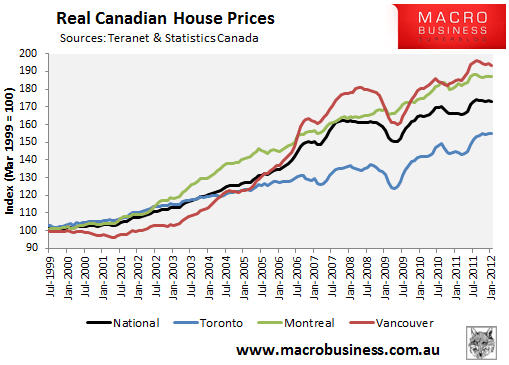
By Leith van Onselen
The Teranet – National Bank Composite House Price Index was released last week, reporting that Canadian house prices recovered slightly after two straight months of declines. According to Teranet:
Canadian home prices in January were up 0.1% from the previous month, according to the Teranet-National Bank National Composite House Price Index™. The rise came after two consecutive months of retreat. Prices were up from the month before in seven of the 11 metropolitan markets surveyed…
The 12-month gain of the composite index was 6.5% in January. It was the second month in a row of deceleration in 12-month inflation, attributable to monthly rises in December 2010 and January 2011 following three straight monthly declines.
The Teranet indices uses a matched sales pair methodology, like the Case-Shiller indices in the United States and the Residex indices in Australia.
Charts showing price movements in Canada’s three largest cities – Toronto, Montreal and Vancouver – as well as nationally are provided below.
First, consider nominal changes in Canadian house prices since July 1999:

According to Teranet, national house prices are down -0.3% since they peaked in September 2011, with Canada’s bubbliest market – Vancouver – leading the way. By contrast, prices in Canada’s largest city – Toronto – have actually risen by +0.8% over this period, whereas Montreal’s house prices remained flat.
Real (inflation-adjusted) price changes are shown below:

In real terms, Canada’s house prices have fallen -0.6% from peak (August 2011), again led by Vancouver, where prices are down by 1.5%.
The +0.1% rise in house prices in January might provide some pause in predictions of impending doom in the Canadian housing market.
In a recent post, Canadian Bubble goes mainstream, I described how the mainstream media (MSM) appeared to have turned from cheerleaders of the rise in Canadian house prices to warning of a possible bubble and/or projecting large price falls.
Another recent development has been the staunch defence of Canadian housing by Canada’s banks, which have a vested interest in maintaining the status quo. A classic example of the banks’ position was provided on Thursday by Ed Clark, chief executive of Toronto-Dominion (TD) Bank.
According to Mr Clark, the Canadian housing market is not facing a US-style meltdown and, even if it did, Canada’s banks are well placed to handle any fallout:
Despite soaring mortgage lending, Canadian banks are strong enough to absorb any hit that might result from a potential real estate correction, said Ed Clark, chief executive of Toronto-Dominion Bank.
Unlike U.S. banks, lenders on this side of the border did not get involved in the kind of risky practices that helped drive the U.S. housing boom of the previous decade and that ultimately caused so much carnage when the crisis hit in 2008, Mr. Clark told shareholders at TD’s annual meeting.
Canadian banks didn’t require government bailouts and were able to go out into the markets and raise significant capital to fortify their balance sheets over the last few years.
If the housing market corrects, the big banks are strong enough “that they could absorb that hit,” he said… Even if real estate does correct, the drop won’t be as severe as the U.S. experience and banks will be prepared to absorb any potential losses owing to their strong capital positions…
Ed Clark’s assertion that Canadian banks have not engaged in ‘risky lending’ is curious, given that they have, for a long time, effectively offered 100% to 103% loan-to-value (LTV) mortgages via generous cash-back offers:
As you may know, the minimum down payment in Canada is 5%. However, one way for lenders to work around this is by getting you a cash back mortgage.
A cash back mortgage provides you with a percentage of your mortgage in upfront funds, which is possible because your house acts as collateral…
Essentially, you can qualify for a 5-year cash back mortgage at 5%, where the 5% cash back is considered to be your down payment. However, on paper, the mortgage is structured as though you put in 5% of your own funds…
Potentially, with a 10 year term, you may be able to procure an 8% cash back mortgage rate. So in theory, you could have 103% financing on your mortgage if you put in a 5% down payment.
Examples of the Canadian banks’ cash back offers can be viewed here.
Further, Mr Clark’s claim that Canada’s banks are strong and that they were able to raise their own capital is true only because the Canadian Government (taxpayers) guarantee the performance of mortgages via the government-owned Canadian Mortgage Housing Corporation, or CMHC (explained in detail here).
With default risk removed and placed squarely on the shoulders of Canadian taxpayers, Canada’s banks have little to fear from a housing bust except slower loan (revenue) growth. Canadian taxpayers, on the other hand, could lose billions in the event that the housing housing market suffers a protracted downturn and a significant number of home owners default on their mortgages. The CMHC is, after all, thinly capitalised, with only 2.1% equity against its overall insurance-in-force – a level only slightly better than the US Government-sponsored Fannie Mae, which in 2007, at the peak of the US housing bubble, had only 1.5% equity against its overall insurance exposures.
With Canada’s housing market holding firm in January, according to Teranet, the CMHC’s capital position looks safe for the time being. However, with the CMHC moving recently to slow the growth of insurance-in-force, and mortgage interest rates likely to rise in the not-too-distant future, it remains to be seen whether mortgage credit growth will be sufficient to maintain Canadian house prices at their current elevated levels. If not, and a large number of Canadians default on their mortgages, taxpayers could be exposed to heavy losses as the CMHC pays-out insurance claims to the banks that engaged in the risky lending.

